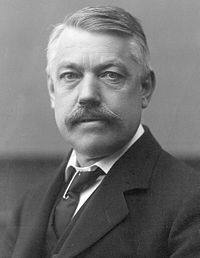
Photo from wikipedia
In this study, the theoretical calculations of CO dissociation were carried out on Cu-Fe alloy surface by a full-potential method, which made more accurate results especially on the prediction of… Click to show full abstract
In this study, the theoretical calculations of CO dissociation were carried out on Cu-Fe alloy surface by a full-potential method, which made more accurate results especially on the prediction of adsorption energies. This process may be governed by either a direct route or a H-assisted via HCO and COH intermediates pathways. In comparison to the pure surface Fe (100), the presence of Cu atom enhanced the activation energy of direct dissociation pathway and decreased that one for H-assisted mechanism through the HCO intermediate by 0.2eV and 0.24eV respectively. These effects were explained completely by the ligand effect and the ensemble effect corresponding to the electronic and geometrical activity of an adsorption-site on different states (initial, intermediate, and final).In this case, Cu impurity atom creates 3-fold-Fe-hollow site instead of 4-fold–Fe-hollow site on the surface as ensemble effect and Fe atoms near the Cu atom show more reactivity according to the ligand effect. The results showed that while both methods, CO-direct dissociation and H-assisted, are feasible on Fe (100) surface, only the later one happens on Fe-Cu surface. The results of this study suggest that Fe-Cu surface with moderate trend for adsorption has a higher life expectancy compared to Fe (100) due to the higher CO-direct dissociation-activation energy to build carbide. Also, by changing the main route from direct to H-assisted, the activity of Fischer- Tropsch reaction is enhanced with lower activation energy versus that one on Fe (100) surface.
Journal Title: Physical Chemistry Research
Year Published: 2017
Link to full text (if available)
Share on Social Media: Sign Up to like & get
recommendations!